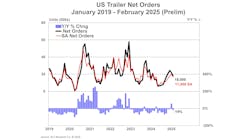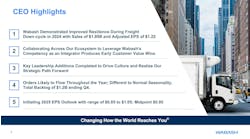Trailer factory shipments will be stuck between 241,000 and 251,000 through 2015, but that’s not a bad thing after recession
KENNY Vieth named his NTDA presentation, “The Great OK: An Overview of US Trailer Demand in Late 2013.”
It doesn’t exactly get the heart racing, but allow him to explain.
“We just came through the Great Recession,” said Vieth, president of ACT Research. “I wanted to name the presentation, ‘The Goldilocks Era,’ but it’s not quite comfortable enough to be not too hot, not too cold. It’s still a little chilly out there. In the middle is ‘The Great OK.’
“The good news is that it’s OK. We’re looking at several years of fairly steady activity. You are not going to have to ramp up your sales staff and then fire everybody in three years because we’ve gone on yet another roller coaster ride in the industry.”
Vieth is forecasting total trailer factory shipments of 241,200 this year, 251,800 in 2014, and 249,700 in 2015.
The breakdown by type:
2013: dry vans 135,000; reefers 36,900; flatbeds 23,000; HLB 3800; MLB 8000; dumps 6100; liquid tanks 8500; and pneumatic tanks 1400.
2014: dry vans 143,000; reefers 36,000; flatbeds 24,200; HLB 4300; MLB 8300; dumps 8500; liquid tanks 8400; and pneumatic tanks 1700.
2015: dry vans 143,000; reefers 34,500; flatbeds 25,200; HLB 3800; MLB 7800; dumps 11,000; liquid tanks 7800; and pneumatic tanks 2100.
“I am loathe to put out flat forecasts, and this is as flat a forecast as I’ve ever put out in the trailer market,” he said. “We’re about 240,000, 241,000 units this year, up to 252,000 next year. We have a bit slower ramp-up in 2014 if this thing lags a bit in Washington. Maybe it’s 235,000 next year as opposed to 250,000.
“I think dry van trailers eventually are going to go away and we will hit a spot in 2016 when we hit a downturn in demand. Because we’re not building up excesses in the economy, because we’re not building up excesses in fleets right now, the clock hasn’t really started ticking on the cycle. It’s generally steady as she goes. This is an industry where in 1999 you built 300,000 trailers and in 2009 you built, or sold, as the case may be, 90,000 trailers. So steady at 240,000 or 250,000 is a good thing.”
Vieth said that from 2007 through 2011, the trailer population fell 8%, or 260,000 units. It was basically unchanged into the end of 2013 at 2.88 million units.
Total trailer replacement is projected to be flat through the forecast: 215,000-220,000 through 2018. In 2011, the fleet age peaked 1.3 years above the average between 1981 and 2007 at 8.3 years. This year was the third-oldest on record at 8.2 years. In 2011, the dry van fleet age peaked at 8.4 years, 1.5 years above the long-run trend. At 1.6 million, the dry population remains 12% below peak, but he said the dry-van-to-tractor ratio is very steady.
His summary:
• A broader base of support should generate stronger growth in 2014.
• The rate of freight growth relative to the rate of productivity growth will determine the extent to which the capacity shortfall will widen.
• There is plenty of aged equipment in need of replacement.
• After getting dinged by Hours of Service in the second half of 2013, truckers should see profits accelerating again by the first half of 2014.
“It’s not enough for the economy to generate the freight,” Vieth said. “It’s not until your customers start making money and get their ROI numbers up to where they want to be that they start doing more than just replacing equipment, and they start adding capacity to their freight.
“Right now, we have a positive outlook. In terms of freight demand, the truck and trailer supply is in balance. Stronger economic growth will tilt the field towards truckers. Trucker profitability rose above ‘replacement’ levels in the first half of this year. They need consistent profitability to justify capacity additions.
“Used truck and trailer valuations are steady. There is good forward visibility for continued favorable used equipment values. Also, there is significantly better fuel economy, an old fleet, maturing super-productivity trends, and regulatory impacts on productivity, liability, and drivers.”
Vieth said there will be slow growth in the overall economy that strengthens into 2014. GDP at 1.7% in 2013 will rise to around 2.6% in 2014.
“Political uncertainty will impact near-term prospects,” he said. “There is a broader base of support: healthy consumer balance sheets, strong corporate profits, rising domestic energy production, a manufacturing renaissance, pent-up residential investment, and low inflation. The caveats: an unproductive domestic political climate, slower emerging market growth, and Eurozone stability.” ♦








